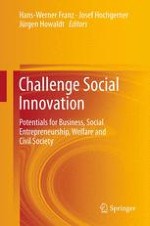2012 | OriginalPaper | Chapter
Social Innovation of Work and Employment
Authors : Frank Pot, Steven Dhondt, Peter Oeij
Published in: Challenge Social Innovation
Publisher: Springer Berlin Heidelberg
Activate our intelligent search to find suitable subject content or patents.
Select sections of text to find matching patents with Artificial Intelligence. powered by
Select sections of text to find additional relevant content using AI-assisted search. powered by
